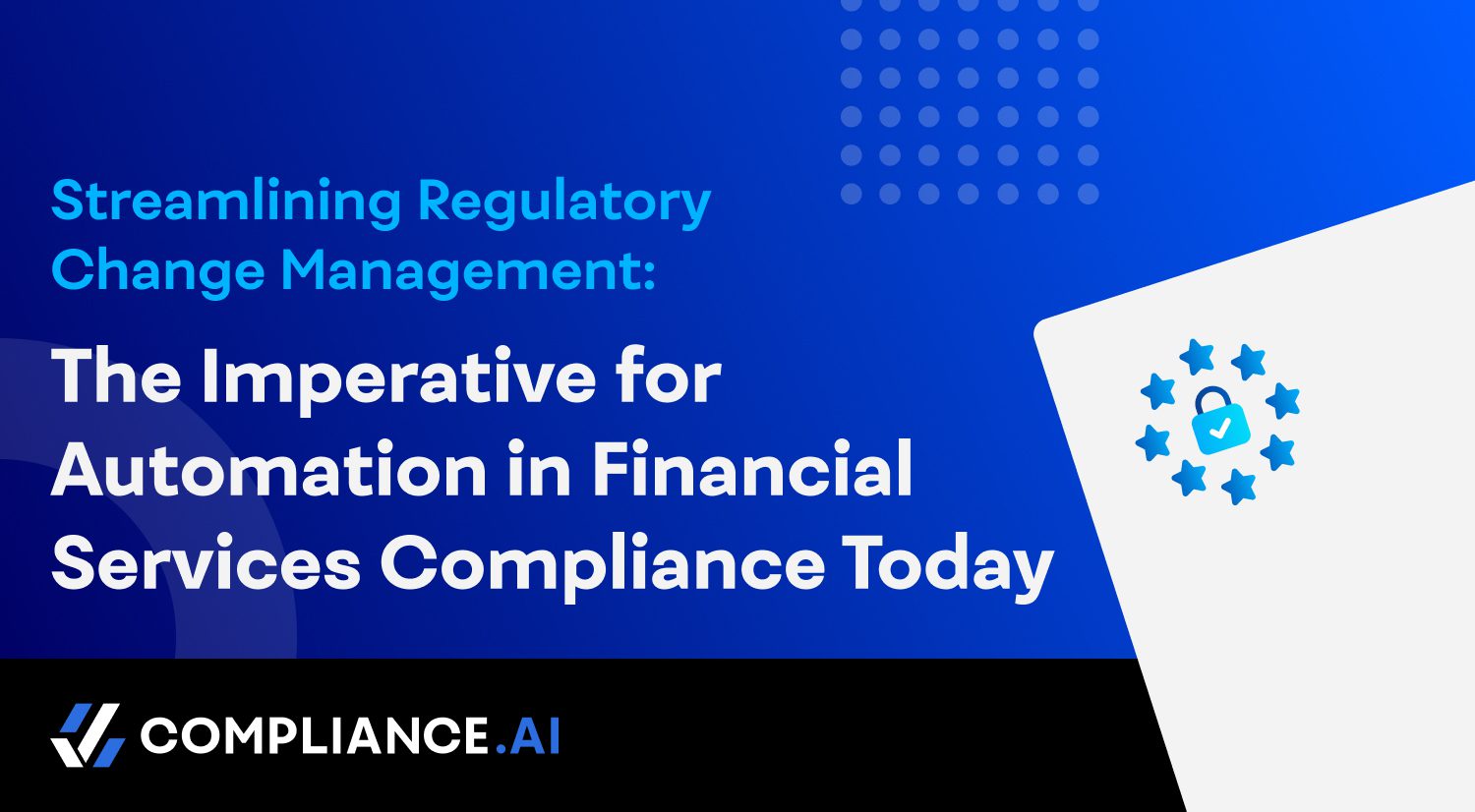Navigating the regulatory landscape in financial services has long been a full-time job. Regulations evolve almost monthly and institutions must continuously adapt their compliance strategies to meet new standards and guidelines.
Therefore, compliance professionals have the difficult, if not impossible, job of identifying relevant regulatory changes, understanding their implications, and then guiding their organizations in implementing necessary adjustments to policies and practices. This process is not only time-consuming but is also full of risk. Humans trying to make sense of regulations in real time is almost always a recipe for disaster and the speed at which regulation can change could make what was legal illegal overnight.
What’s the answer? Automation.
Automation offers the potential to streamline the compliance process, reduce the risk of errors, and enable compliance teams to focus on strategic aspects of their roles rather than getting bogged down in the minutiae of regulatory updates.
The Rise of Regulatory Automation
Automation leverages technology to systematically monitor, analyze, and implement regulatory changes across various jurisdictions and regulatory bodies. This approach not only simplifies the process of staying current with the latest regulations but also significantly reduces the likelihood of human error and the burden associated with manual compliance tasks. By integrating sophisticated algorithms and artificial intelligence, automated systems can swiftly identify relevant regulatory updates, assess their impact on the organization, and guide the necessary adjustments to policies and procedures. And, best of all, these automated systems will “show the work,” ensuring that the humans in the loop aren’t thrown for a loop with an unexpected change.
The State of the Art Isn’t So State of the Art
The current state of regulation in the financial services sector is marked by both complexity and an overwhelming volume of change. Financial institutions are under constant pressure to adapt to a steady stream of new and updated regulations that span across all aspects of their operations. This environment is not only challenging due to the sheer number of regulations but also because of their complexity. Each regulation comes with its own set of rules and requirements, often with nuanced differences depending on the jurisdiction. Just as no one person can understand the vagaries of a particular business, no one person can keep track of the constant changes associated with compliance.
Key regulations that exemplify these challenges include the General Data Protection Regulation (GDPR) in the European Union, which sets stringent data protection and privacy standards; the Dodd-Frank Wall Street Reform and Consumer Protection Act in the United States, which introduced a comprehensive set of financial regulatory reforms post-2008 financial crisis; and the Markets in Financial Instruments Directive II (MiFID II) in Europe, aimed at increasing transparency across the financial markets. Each of these regulations has significantly impacted how financial institutions operate, requiring them to invest in new technologies, processes, and personnel to ensure compliance. And, what’s worse, many of the regulations are vague or inapplicable to a certain business. Further, no one can say when or who will crack down on a certain part of the regulatory system, leading to the need to over prepare for a problem that might never rear its head.
That said, the implications of non-compliance with these and other regulations can be severe. Financial penalties for breaches can reach into the billions, eroding profits and affecting the bottom line. Beyond the financial impact, non-compliance can also lead to reputational damage that can be far more destructive in the long term. Loss of customer trust and confidence can result in a decline in business, while the negative attention from media can further tarnish an institution’s image. Regulatory bodies may impose operational restrictions, hindering the institution’s ability to conduct business.
How, then, do you manage this situation? There are a few trends that are making it easier and far more efficient to survive the storm.
Trends In the Regulatory Space
The landscape of regulatory change management is continuously evolving, shaped by several key trends that underscore the challenges and opportunities facing financial institutions today. One notable trend is the increasing frequency and scope of regulatory updates, reflecting a global push towards tighter financial oversight in response to past crises and the rise of new financial technologies. This environment demands that institutions not only keep pace with current regulations but also anticipate future changes.
Simultaneously, there’s a growing reliance on technology and data analytics within the compliance sector. Financial institutions are leveraging these tools to gain insights into vast amounts of regulatory data, enhancing their ability to identify relevant changes and assess their impact more efficiently. This trend highlights the importance of sophisticated data management strategies in supporting compliance objectives.
Another shift is the emphasis on proactive risk management and regulatory monitoring. Rather than reacting to regulatory changes as they occur, institutions are increasingly adopting forward-looking approaches that emphasize ongoing vigilance and preparedness. This proactive stance is essential for mitigating potential compliance risks and aligning regulatory strategy with business objectives.
There’s a clear shift towards integrated and automated compliance solutions. These platforms offer a holistic approach to managing regulatory changes, combining monitoring, analysis, and implementation functions into a cohesive system. By reducing the reliance on manual processes, these integrated solutions enable more efficient and effective compliance management.
Automating For Efficiency
Automation stands at the forefront of transforming regulatory change management, offering several pathways to increased efficiency within financial institutions. Firstly, the accelerated identification and assessment of regulatory changes are made possible through AI-powered algorithms and natural language processing. These technologies can sift through vast amounts of regulatory information, identifying pertinent changes quickly and accurately.
Automated tracking and monitoring of regulatory updates from various sources, including regulatory agencies and industry publications, ensure that financial institutions remain abreast of all relevant changes. This comprehensive coverage is crucial for maintaining compliance across different jurisdictions and regulatory frameworks.
Streamlined impact assessment and gap analysis further enhance the efficiency of compliance efforts. By automating these processes, institutions can prioritize their compliance activities more effectively, focusing resources on areas of highest impact or risk. This targeted approach facilitates a more strategic allocation of compliance resources.
Lastly, automated workflows for implementing and documenting regulatory changes within the organization not only expedite the compliance process but also ensure thorough documentation and traceability. This capability is vital for demonstrating compliance to regulatory bodies and minimizing the risks of non-compliance penalties and reputational damage.
Real-time reporting and compliance analytics can make a manager’s difficult job surprisingly simple. By creating a feed of regulatory information and, potentially, allowing for automatic auditing via AI, a manager can immediately learn about and remedy regulatory issues as they arise.
Looking Forward
The potential for further advancements in automation technologies, including machine learning and predictive analytics, holds promising prospects for regulatory change management. These technologies could offer even more sophisticated tools for predicting regulatory trends, enabling financial institutions to prepare for changes more proactively. Additionally, the integration of automation into broader risk management and governance frameworks could further enhance the strategic oversight of compliance processes, making them more efficient and effective. There are also significant collaboration opportunities between regulators, industry stakeholders, and technology providers. Such collaborations can drive innovation in regulatory compliance, helping to develop solutions that are not only effective but also adaptable to the changing regulatory landscape. These future directions underscore the ongoing evolution of regulatory change management and the central role that automation will continue to play in shaping its development.
A Call to Action
The need for automation in regulatory change management within financial services compliance has never been more apparent. With the regulatory landscape becoming increasingly complex, automation stands out as a strategic imperative for financial institutions. It promises not only to increase efficiencies and reduce the compliance burden but also to significantly enhance the overall regulatory compliance posture of organizations.
The transformative potential of automation underscores a critical call to action for financial institutions: to embrace and invest in automated solutions as a cornerstone of their compliance and risk management strategies. By doing so, they can navigate the complexities of the regulatory environment more effectively and secure a competitive edge in the financial services sector.
Compliance.ai has developed a platform that addresses the critical needs of enterprise regulatory change management. Designed to mitigate risk, reduce costs, and increase confidence in compliance status for the entire enterprise in the banking, financial services, and insurance industry, customers use Compliance.ai to automatically monitor regulatory updates, identify obligations, and ensure required changes are completed. To learn more and see how automation can effectively streamline your processes, try out our Compliance Pro edition.


